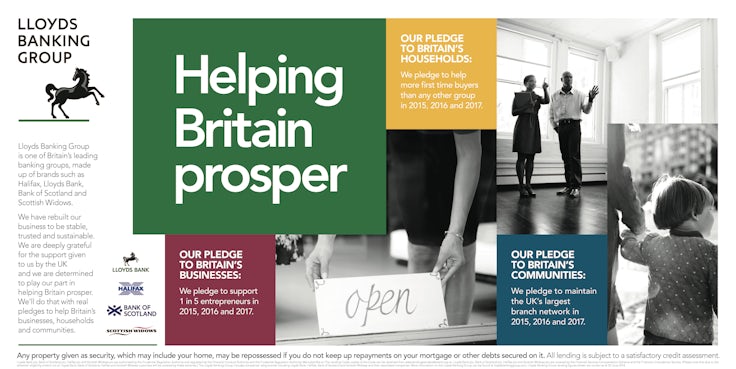Building the Lloyds Banking Group corporate brand
Lloyds Banking Group’s decision to launch its first multi-brand campaign detailing how its Lloyds, Halifax and Bank of Scotland brands are “Helping Britain Prosper” the week it announced the closure of 200 branches and the loss of up to 9,000 jobs might seem odd or necessary, depending on your level of cynicism.

The campaign, which launched last week, details the work its banks do in helping communities, businesses and households, while expressing “deep gratitude” for the support “given to us by the UK “.
The latter refers to the bailout forced upon the company amid the financial crisis in 2009 that left the group a third owned by taxpayers. Since, the group has undergone a huge overhaul resulting in thousands of job losses, the spin-off of TSB and subsequent relaunch of Lloyds Bank.
Rebuilding process
It has spent the years since attempting to understand and define its purpose as a part state-owned company and a compelling proposition to customers and investors culminating first in the publication of seven commitments aimed at tackling some of the “big issues” facing Britons – lack of affordable housing or finding a job, for example – earlier this year and now its first multi-brand campaign.
The activity also comes amid relative financial stability for the Group, it returned to profit for the first time in three years in February, and the campaign also serves as an awareness tool ahead of the anticipated sale of the Government’s stake next year.
Addressing brand confusion
Catherine Kehoe, the group’s managing director for retail brands and marketing told Marketing Week the activity aims to address the often “very confused” perception of who and what Lloyds Banking Group is.
“The campaign is about talking about Lloyds Banking Group as a whole entity to try and make people understand that the portfolio of brands is very strong and collectively the banking group has a strong set of commitments around making Britain prosper.
“We do that through strong brands that help people in business and communities. We are the first banking group to measure the economic and social impact we have as a group. We’re really pleased about it internally but we haven’t really talked about it to the general public to know. It felt like the right time, the next stage of our group strategy, positioning the banking group in terms of what it’s here to do.
“People confuse Lloyds Bank with Lloyds banking group a lot of the time, which is fine but Lloyds Banking Group is much richer than just Lloyds Bank. “It has Bank of Scotland, Halifax and Scottish Widows who are all doing brilliant and powerful things. “
Brand purpose
Brand purpose and demonstrating values is now seen as a key tenet of all marketing strategies but in financial services it is a space only non-PLCs such as Nationwide and untainted brands such as TSB have occupied to now.
Kehoe adds that the sector needs to communicate its purpose more than any.
“We have an obligation to make people understand that Lloyds Banking Group has a fine and noble purpose around making Britain prosper. I would want to know that it has at its heart something that I can relate to in terms of its values. I think its important and something to be proud about.”
“We have an obligation to make people understand that Lloyds Banking Group has a fine and noble purpose around making Britain prosper.”
The launch of the group campaign comes just over a year after the relaunch of Lloyds Bank, which was formed after the group was forced to divest 600 branches, a business that was branded TSB and is now prospering as a standalone entity. The launch was backed with a £30m campaign that highlighted how Lloyds was there for the important “moments that matter” in people’s financial lives. It also attempted to cement Lloyds’ “relationship bank” positioning and set it apart from “community bank” sister brand Halifax.
Lloyds Bank, one year on
Kehoe says the campaign “landed well” with its intended retail and commercial banking audience, among both customers and non-customers. She points to successes such as mobile banking take-up (2.5 million mobile only customers), a key priority for Lloyds as it looks to digitise banking and justify branch closures.
She adds Net Promoter Scores for Lloyds reflect this. “In terms of how we measure through consideration and satisfaction the perception is the positioning reflects experience and what matters to them,” she adds.
However, You Gov BrandIndex brand data tracking highlights the challenge Lloyds Bank faces in regaining some of the goodwill lost after the financial crash and subsequent sector wide scandals such as the miss-selling of payment protection insurance.
Lloyds’ Buzz score – a net measure of the positive and negative things people think about a brand – is -28.6, down -24.3 points in a year and putting Lloyds bottom in a list of 27 high street banking brands
Its Index score, a net balance of how consumers rate a brand in terms of quality, general impression, value, reputation and recommendation is only slightly better with a score of -11.1 down -3.6 and putting it second bottom ahead of only Royal Bank of Scotland.
Work still needed
Kehoe acknowledges that despite the progress made “we still have a long way to do to be better for customers.
“We have made a huge amount of progress in terms of our Lloyds Banking Group strategy but there is still a lot more to do.
“We need to invest in areas where customers are and what they want from their banks before we can say we have become best bank for customers before we have rebuilt trust and there’s so much more to do.
“Across all of our brands we are very focussed on understanding customer service satisfaction, consideration is very important underpinned by rebuilding trust in a difficult environment where customers have lost a lot of trust in their banking relationship. We have all got a lot to do across the banking sector to make people see we are not all the same that we are genuinely prioritising what’s right for customers over what is right for them.
“We are doing it for our customers not because we are under pressure from regulators to act but because we want to deliver best service to customers and service.”







